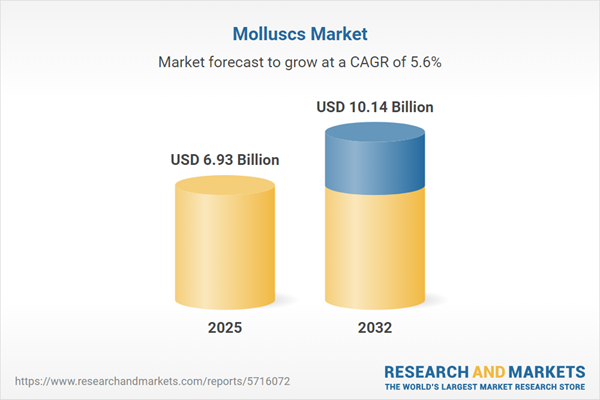Speak directly to the analyst to clarify any post sales queries you may have.
Molluscs are central to both food supply chains and diverse industrial sectors, presenting unique complexity for senior leaders tasked with navigating evolving regulatory demands, optimizing operational models, and integrating advanced technology for sustained competitiveness.
Molluscs Market Snapshot
The molluscs market continues to achieve steady momentum, reporting rising revenues and projecting strong ongoing expansion. Progress is driven by aquaculture innovations, broader product portfolios, and digital transformation across distribution networks. The sector actively adjusts to evolving compliance requirements and shifting trade policies, ensuring robust adaptability across mature and emerging markets. This resilience enables industry stakeholders to address fluid global demand and regulatory landscapes, providing a foundation for effective long-term risk management and agile response to new opportunities.
Scope & Segmentation of the Molluscs Market
For executive decision-makers, a thorough assessment of the molluscs market involves tracking major operational segments, emerging technologies, and the diversity of regional dynamics influencing value creation:
- Species Type: Includes bivalves, cephalopods, and gastropods, each requiring tailored operational strategies and opening distinct avenues for both seafood and non-food markets.
- Product Form: Spans canned, fresh, and frozen variants, supporting supply chain agility and customized solutions for distributors and end-users.
- Distribution Channel: Primary channels encompass seafood markets, major supermarket retailers, and online platforms, each facilitating B2B procurement and expanding reach into new customer segments.
- End User: Encompasses food service, packaged food production, and industries such as cosmetics and pharmaceuticals, driving revenue diversification and mitigating single-sector exposure.
- Regional Coverage: Market presence cuts across the Americas, Europe—including Germany, the UK, and Spain—the Middle East, Africa, and Asia-Pacific, with each geography presenting unique compliance and growth considerations.
- Technology Focus: Encompasses selective breeding, offshore aquaculture, process automation, cold-chain logistics, biotechnology applications, and digital traceability initiatives promoting sustainable operations and transparency.
- Leading Players Monitored: Major participants include Maruha Nichiro Corporation, Nippon Suisan Kaisha, Thai Union Group, Charoen Pokphand Foods, Mitsubishi Corporation, Mowi ASA, Dongwon Industries, Marubeni Corporation, Itochu Corporation, and High Liner Foods—setting performance benchmarks and shaping collaborative or competitive strategies.
Molluscs Market: Key Takeaways for Senior Decision-Makers
- Digital solutions are deepening end-to-end supply chain transparency, enabling rapid response to regulatory shifts and evolving buyer preferences.
- Diversified, premium, and sustainably certified product lines are preparing organizations to meet sector standards and enhance access to high-value customer segments.
- Embedding ethical sourcing frameworks and supplier certifications strengthens compliance positions and builds trust with regulatory bodies and strategic partners.
- Strategic partnerships across aquaculture, feed, and allied supply networks enhance operational continuity during periods of regulatory or market disruption.
- Automated compliance and management systems streamline global transactions, minimizing regulatory risk and ensuring consistent performance along the value chain.
Tariff Impact on Molluscs Market Dynamics
Recent tariff introductions in the United States have led senior executives to reinforce domestic sourcing strategies and deepen supplier collaborations. The rapid adoption of digital platforms is facilitating efficient tariff management, complemented by real-time analytics for agile operational decision-making. Cross-functional teams are proactively engaged to maintain flexibility and business continuity amid ongoing international market fluctuations. These steps enable swift adaptation to changing external constraints, preserving supply chain efficiency and mitigating unforeseen disruptions.
Methodology & Data Sources
This analysis draws from executive interviews, specialized industry publications, regulatory datasets, and contributions from aquaculture and food science experts. Validation and cross-referencing of data ensure that insights are accurate and actionable for strategic planning purposes.
Why This Report Matters for Senior Strategy
- Provides up-to-date insight into the regulatory, digital, and consumer-driven trends influencing the molluscs market.
- Delivers actionable recommendations for optimizing operational processes and guiding technology investments across the global value chain.
- Supports informed benchmarking, risk assessment, and partnership evaluation, equipping executive teams to navigate change and secure strategic positioning.
Conclusion
This report supports senior decision-makers with in-depth market intelligence and actionable clarity, equipping them to advance organizational resilience and maintain performance as global industry conditions evolve.
Additional Product Information:
- Purchase of this report includes 1 year online access with quarterly updates.
- This report can be updated on request. Please contact our Customer Experience team using the Ask a Question widget on our website.
Table of Contents
3. Executive Summary
4. Market Overview
7. Cumulative Impact of Artificial Intelligence 2025
Companies Mentioned
The companies profiled in this Molluscs market report include:- Maruha Nichiro Corporation
- Nippon Suisan Kaisha, Ltd.
- Thai Union Group Public Company Limited
- Charoen Pokphand Foods Public Company Limited
- Mitsubishi Corporation
- Mowi ASA
- Dongwon Industries Co., Ltd.
- Marubeni Corporation
- Itochu Corporation
- High Liner Foods Incorporated
Table Information
| Report Attribute | Details |
|---|---|
| No. of Pages | 199 |
| Published | October 2025 |
| Forecast Period | 2025 - 2032 |
| Estimated Market Value ( USD | $ 6.93 Billion |
| Forecasted Market Value ( USD | $ 10.14 Billion |
| Compound Annual Growth Rate | 5.5% |
| Regions Covered | Global |
| No. of Companies Mentioned | 11 |









